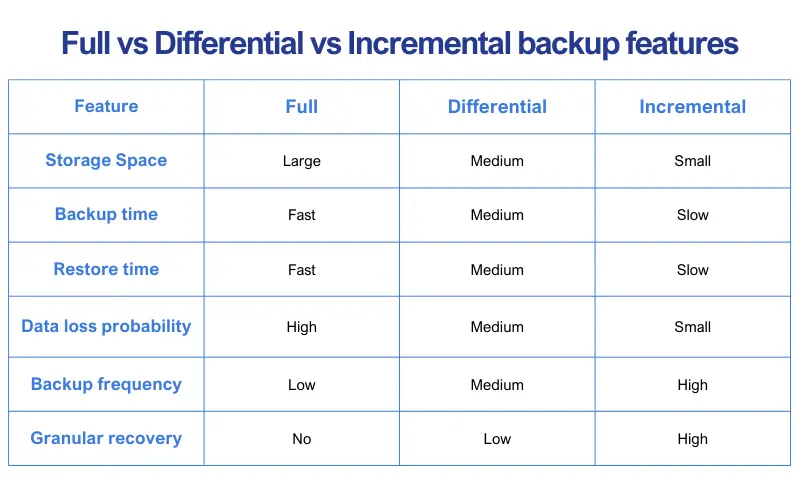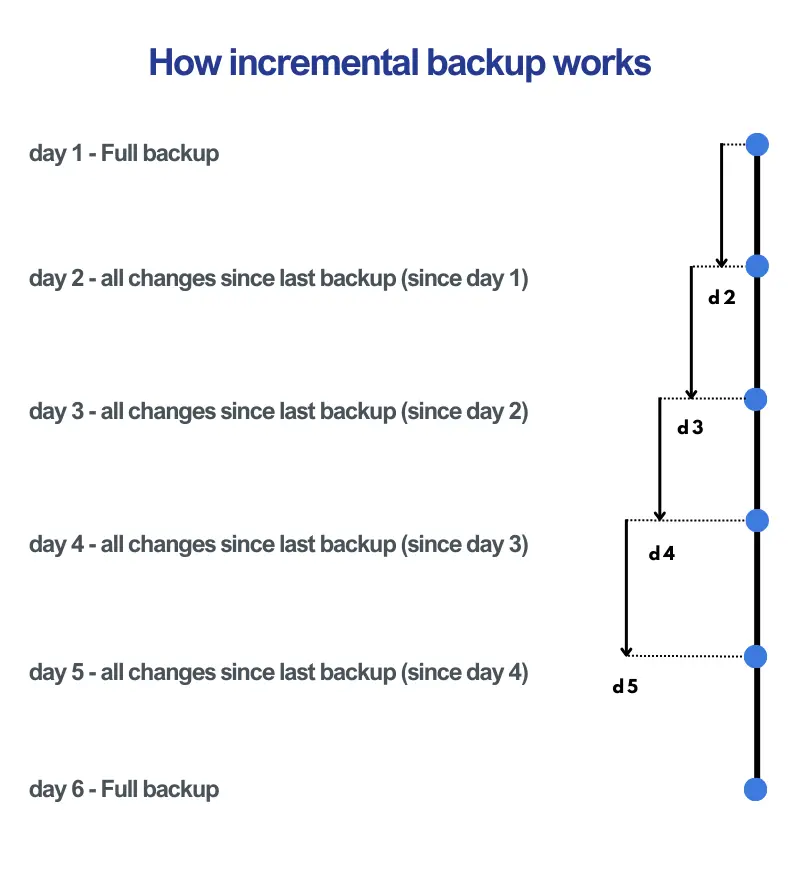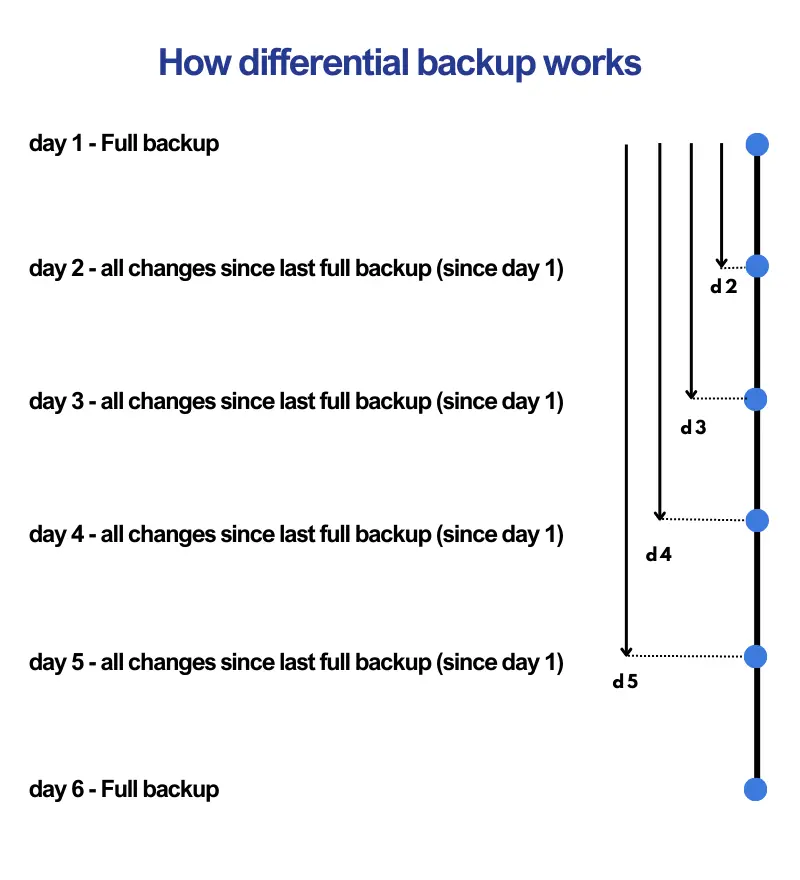Full vs Incremental vs Differential Backup: Which Is The Best?
How Many Types of Backup are There?
There are three key backup techniques on which all the types and their respective subtypes are based. The first technique stipulates the copying of the entirety of the data. The second one is based on duplicating the data modifications that have happened over a defined period. Combined, these techniques create several types of backup, each having its strengths and weaknesses.
These are:
- Full
- Synthetic full
- Incremental
- Incremental
- Forever incremental
- Reverse incremental
- Differential
- Mirror
- Continuous data protection (CDP)
The last type of backup mentioned in the list is often omitted from the articles like our own. You can think of CDP as an uninterrupted stream of the edits performed on the data. It reduces Recovery Point Objective to zero but takes disproportionate storage space.
We suggest reading a blog post by SpinOne on continuous data protection.
Full vs Differential vs Incremental Backups: One-Glance Comparison
To help visualize the differences between these backup types, let’s take a look at the following table:
| Full backup | Differential backup | Incremental backup | |
| Data that is backed up | All data | Data that has been changed since the last full backup | Data that has been changed since the last backup of any type |
| Storage space | The highest | Medium to high | The lowest |
| Backup time | The slowest | Fast | The fastest |
| Recovery time | The fastest | Fast to medium | On-prem: The longest
In the cloud: Fast/medium |
| Full data restore procedure | Requires the last backup only | Requires most recent full and differential backups | Requires most recent full backup and all incremental backups |
| Duplicates | The highest amount | Medium amount | No duplicates |
Check out the tables for quick reference for the distinctions between backup types.

Let’s proceed to examine this topic in more depth.
Full Backup
A full backup is a total copy of every single file you allocate to be backed up as often as you set it up to be. Let’s say you determine your backup service to conduct a full backup of your cloud or on-premises data 5 times a week. Regardless of the changes in the old documents and the addition of new ones, a full backup will daily create a copy of:
- The old files
- The changes you made in the old files
- The new files
Essentially, a full backup copies the entire data center each time, which doesn’t make having it daily the smartest idea. Most companies, regardless of size, should do a full backup once or twice a week, preferably on Mondays or Fridays. They should also do smaller backups on the other days.
Pros:
- Reliability due to a full recovery. You can restore all the lost data without any missing pieces;
- Convenient and simple to access. The correct data order will be unchanged and restored accordingly;
- The fastest recovery. The full backup takes the shortest recovery time since it can restore all the lost files from only one last copy.
Cons:
- Space-consuming. A full backup doubles each day’s files and adds new files and changes along with it, making it the most space-demanding type;
- The slowest backup time. The more files you have to copy, the more time it takes to do that;
- High bandwidth demand. Bandwidth is required to travel high volumes of data throughout the servers regularly. To perform full backups, you’ll need a lot of it.
Incremental Backup
An incremental backup is a more focused backup that usually follows the last backup. An incremental backup saves all the changes made since the previous backup. It doesn’t copy already backed files—only those that were newly changed or created. It helps to reduce the need for bandwidth and save storage space and backup time.

Let’s look at the example:
Monday: A full data backup.
Tuesday: The incremental backup analyzes your entire system to save only Tuesday’s changes without copying Monday’s backup.
Wednesday: The backup saves what was added/changed on Wednesday only. The same goes for Thursday and Friday.
Pros:
- Minimal time to back up files. An incremental backup saves the smallest amount of data, which requires the minimum time;
- Minimal storage space needs. The backup portions are the smallest here, making the incremental type the most economical one in terms of storage;
- Minimal bandwidth requirements. Again, the lower the data volumes, the less bandwidth is required.
Cons:
- The longest recovery time. To complete the recovery, you often need to restore a full backup along with the incremental ones. Also, you need to restore it in the same order it was backed up and piece those parts together to keep the consistency;
- The risk of incomplete recovery. Data sets are backed up and restored separately, so if they fail to restore or are compromised, you may experience downtime due to the partial data recovery.
Differential Backup
A differential backup is similar to an incremental one but with one important difference. If an incremental backup saves changes made after any last backup, a differential backup saves the data that has been changed since the full backup.
Let’s go back to our example.

Monday: A full data backup.
Tuesday: It backs up Tuesday’s data;
Wednesday: It backs up Tuesday and Wednesday’s data;
Thursday: It backs up Tuesday, Wednesday, and Thursday’s data, and so on.
The next week’s differential backup will be referencing the next Monday’s full backup.
As you can see, it copies information not only from this day but also from the previous weekdays since the last full backup.
Using this type, you load less backup storage space than using a full backup but more than an incremental one.
Pros:
- Less required storage than with full backup;
- Faster backup time than with full backup;
- Fast and reliable recovery. You need only two data sets: the full backup and the last copy of the differential one.
Cons:
- Restoration is slower than from a full backup;
- The backing-up process is slower than with incremental backup;
- The storage demands are higher than with the incremental backup.
Mirror backups
Some companies like those that trade stocks conduct operations that are extremely dependent on time. They need swift data recovery after an incident. That’s where mirror backups are applicable.
This type makes an image of a file system, however, omits certain data (like file versions). Think of this type as an attempt to cut down the resources required for the full backup, i.e. time and storage space.
Pros & cons
Strengths: Quickest recovery.
Weaknesses: Highest data loss probability.
Backup Subtypes
This section describes the various backup subtypes designed to minimize the drawbacks of the main types.
Synthetic full backup & Reverse incremental backup
These two types are similar in their working principles. They start with a comprehensive data copy followed by a series of incremental backups. The latter are then incorporated into the initial copy. They write over the old data destroying it.
The difference between these types is that, unlike synthetic, the reverse type stores incremental copies. It can then restore them thus allowing fewer data to be irrecoverable.
Forever incremental backup
As stipulated in one of the previous sections, the incremental type makes complete data replicas with a particular regularity (once a week, once a month, etc.). Unlike it, the forever type has only one initial full copy of your data followed by incremental backups.
What is achieved as a result? You’ll have to endure the longest waiting time for restoration. However, you’ll spend fewer Bites as opposed to the classical incremental type.
Questions to Determine Which Backup Type You Need
The type of backup you should choose depends on many things you should consider when creating your backup strategy. You can check out the full list of best practices for a successful backup strategy here.
What is the main reason to back up your data?
Data losses affect companies in different ways. For one company, it can interrupt the business continuity and stop all the processes, which will lead to downtime. For another company, the main consequence of data loss will be the need to pay legal fees for compliance violations.
Or maybe, in your case, these two are equally important. In both cases, you need backups to save your data, but the data will be different.
In the first case, the data will be updated frequently and have to be both backed up and restored as fast as possible to keep the processes going. If that’s the requirement, we advise you to follow the practice of 2 full backups + 3 incremental backups a week.
In the second scenario, the data may not get updated for weeks, months, or even years, so both backup and restore time don’t matter that much. Then the best option will be to have 90% of all backups incremental while creating full backups only occasionally.
What is your recovery time maximum?
Downtime is the most costly part of data loss. The higher the stakes, the more demanding you should be in terms of recovery time. So if you have no tolerance for downtime, a full backup will be the best choice that has the fastest recovery speed and represents the least risk. But as creating a full backup every day can be too heavy on your computing and storage capabilities, you can combine it with other backup types in a 50/50 or other comfortable proportion.
Note: Recovery time depends on many factors, and the backup type is only one of them.
Here are the main ones:
- The amount of data to restore
- Whether it is an on-site, off-site, or cloud backup
- The type of cloud storage (private, public, or hybrid) you use if you have cloud backup
- The bandwidth
- The servers’ locations, etc.
Every detail matters, so be sure to consider all the factors.
Do you opt for the on-premises systems or cloud backup?
For example: If you opt for a cloud backup, the recovery for an incremental backup will be much faster than for an on-premises backup.
Read more about why cloud-to-cloud backup is better for your business than on-premises here →
How often do you change/update your databases?
Most organizations don’t update their data assets very often. Most of the data you need to back up may be left from the previous employees and are required to retain for regulatory reasons. If that’s the case, we advise you to opt for the common practice of having a full backup once a week or two and having an incremental or differential backup every other workday.
The other case is when you have “living” data that gets updated every day at high volumes and is your organization’s living force. Then be sure to create full backups at least twice a week, diluting them with incremental or differential backups.
How much storage space can you dedicate?
If you’re planning on using on-premises services for your backup, having a full daily backup will be problematic as it requires the most space and bandwidth unless you have extensive resources. It gets much simpler with cloud backup, where the scalability is much higher and cheaper.
Related read: If you don’t know what specifications to look for in a backup service, check out the article How to Choose a Cloud Backup Provider in 10 Steps.
The Optimal Backup Service Based On Your Answers
Consider if you are a small-to-medium business with 5-300 employees or an enterprise-sized company with 300+ employees, that:
- is transitioning to or already keeps its data in the cloud on platforms like Google Workspace or Microsoft 365
- has limited resources in terms of storage cost, headcount, network traffic, and bandwidth
- needs frequent backups to secure day-to-day data flow in case of disaster
- needs to retain data for an extended period while not spending money on expensive licenses with Google Vault or Microsoft eDiscovery functions
- needs both backup and restore time to be as fast as possible
- needs to be able to restore multiple versions of a file
- needs their data to be placed in data centers located in specific regions to comply with data regulations
- needs a simple, user-friendly interface
If you can apply all or most of these points to your situation, the best option for you is a secure, cloud-to-cloud backup service that does mainly incremental backups.
One such service is Spinbackup. By choosing it, you get:
- Fast incremental backups up to 3x a day on Microsoft’s AWS, Google’s GCP, Amazon’s Azure, or custom cloud storage
- Quick data restore thanks to granular backup, which usually takes minutes (but depends on the amount of data)
- Compliance with such data regulations as SOC 2, EU Privacy Shield, and GDPR
- The ability to restore any version of the file
- The ability to save up to 64% on Google Workspace or Microsoft 365 licenses to save leaving employees’ data
To check if Spinbackup will be a good fit for you:
Was this helpful?
How Can You Maximize SaaS Security Benefits?
Let's get started with a live demo
Latest blog posts
Brewing Trouble: How a Starbucks Ransomware Attack Poured Cold Wate...
Cybercriminals often carry out attacks around holidays as this helps to ensure the most amount...
How to Recover Deleted Messages from Microsoft Teams
In modern-day hybrid and remote work environments, collaboration and communication tools like Microsoft Teams are...
Data Loss Prevention Techniques for 2025 and Beyond
It’s painstakingly clear that data loss is a major challenge facing businesses today. Our experts...


